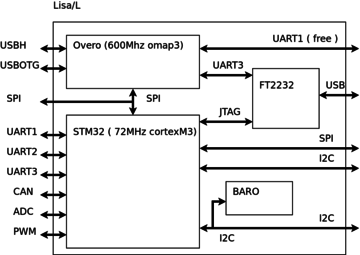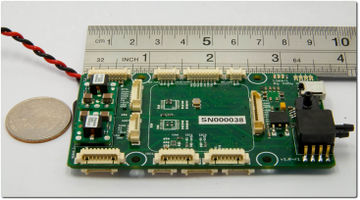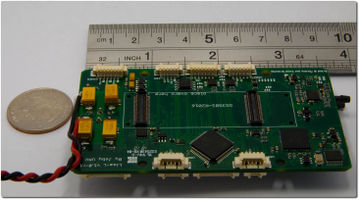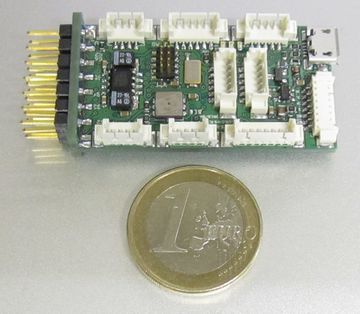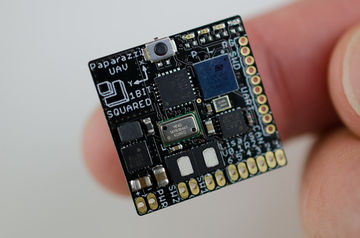Difference between revisions of "Lisa"
Aerodolphin (talk | contribs) |
IHaveADrone (talk | contribs) m (typo) |
||
| (50 intermediate revisions by 12 users not shown) | |||
| Line 1: | Line 1: | ||
Lisa ( the Lost Illusions Serendipitous Autopilot) is a | <categorytree style="float:right; clear:right; margin-left:1ex; border: 1px solid gray; padding: 0.7ex;" mode=pages>Autopilots</categorytree> | ||
There's no such thing as a perfect autopilot, only autopilots adapted to a particular purpose. This is the reason why Lisa | __TOC__ | ||
Lisa ( the Lost Illusions Serendipitous Autopilot) is a range of autopilots based on [http://www.st.com/mcu/inchtml-pages-stm32.html STM32] microcontrollers ( CortexM3@72Mhz ) designed to run Paparazzi. | |||
There's no such thing as a perfect autopilot, only autopilots adapted to a particular purpose. This is the reason why the Lisa autopilots come in different styles for different uses. | |||
The first members of the family are: | The first members of the family are: | ||
| Line 6: | Line 8: | ||
*Lisa/L, a design where the STM32 is associated to a gumstix [http://www.gumstix.net/Setup-and-Programming/cat/Overo-Setup-and-Programming/111.html Overo]. | *Lisa/L, a design where the STM32 is associated to a gumstix [http://www.gumstix.net/Setup-and-Programming/cat/Overo-Setup-and-Programming/111.html Overo]. | ||
*Lisa/M, a design focusing on cost and simplicity. | *Lisa/M, a design focusing on cost and simplicity. | ||
*Lisa/S, a design focusing on size and weight. | |||
=Lisa/L= | ==Lisa/L== | ||
== Description == | === Description === | ||
Lisa/L is a dual processor board autopilot designed to allow the possibility of using Linux for Paparazzi airborne code. | [[Lisa/L]] is a dual processor board autopilot designed to allow for the possibility of using Linux for Paparazzi airborne code. | ||
[[Image:lisa_l_bloc_diag_simple.png|360px]] | [[Image:lisa_l_bloc_diag_simple.png|360px]] | ||
[[Image:lisa_l_top.png|360px]] [[Image:lisa_l_bot.png|360px]] | [[Image:lisa_l_top.png|360px]] [[Image:lisa_l_bot.png|360px]] | ||
== Documentation == | === Documentation === | ||
The documentation | The documentation for Lisa/L is broken into several parts due to board complexity and Gumstix [[Overo]] integration. | ||
* [[Lisa/L|Main Documentation]] - primary hardware documentation and intro to software | |||
* [[Dev/LisaL|Additional Developer Documentation]] - additional advanced hardware and software documentation and notes | |||
* [[LisaL_Gallery|Lisa/L Photo Gallery]] - pictures of [[Lisa/L]] | |||
* [[User/LisaL/Tutorial/Quadrocopter|Unfinished Rotorcraft Tutorial]] - rotorcraft tutorial, needs considerable work | |||
* [[User/LisaL/Tutorial/FixedWing|Unfinished Fixedwing Tutorial]] - fixedwing tutorial, needs considerable work | |||
* [[OMAP|Gumstix Integration Intro]] - intro and documentation listing for integrating a Gumstix Overo with [[Lisa/L]], including for USB devices and cameras | |||
== Lisa/M == | |||
=== Description === | |||
[[Lisa/M]] is a great general purpose small-footprint autopilot. There are currently two versions that have been produced. Detailed documentation can be found here: | |||
* [[Lisa/M_v2.0|Lisa/M v2.0 (current) Documentation]] | |||
[[Image:LisaM_V2_0_TopView.JPG|360px|Lisa/M v2.0 Top View]] | |||
Lisa/M | |||
* [[Lisa/M_v1.0|Lisa/M v1.0 Documentation]] | |||
Lisa/M | |||
[[Image:lisa_m_top_small.png|360px|Lisa/M v1.0 Top View]] | |||
=== Usage scenarios === | |||
There are many potential applications for the small, relatively inexpensive and flexible [[Lisa/M]]. For regular Autopilot boards a fully equip [[Lisa/M]] board is needed. For some scenarios just a basic [[Lisa/M]] without an [[Inertial_Measurement_Units|IMU]] and barometric pressure sensor is needed, which reduces the board cost. Here are some ideas (not all have yet to be implemented): | |||
* As a basic Autopilot | |||
** To use the [[Lisa/M]] as an autopilot, you need to attach a GPS receiver. A nice [[GPS#u-Blox_LEA_Series_Receivers|uBlox LEA-5H]] or newer will perform great. | |||
* As an advanced Autopilot | |||
** Additional sensors for measuring airspeed, current, etc. would enhance a fixed-wing airframe. | |||
* As a servo extender | |||
** Sometimes being able to control seven actuators is just not enough. Large airframes may require flaps or an airbrake and automatic landing facilities. Maybe special ACL/Nav lights, or four cameras with zoom. By using a coupled second basic [[Lisa/M]] and connecting this to the master Autopilot board we can extend the amount of servos. Large airframes can also benefit from remote and/or redundant servo drivers. | |||
* As a Safety Pilot Device | |||
** To provide an extra safety level required in some UAS challenges. A second [[Lisa]] board can make it easy to adhere to the rules for such a challenge. | |||
* As a Data Logger | |||
** Maybe you have a need only to log all kinds of data, like temperature, volts, amps, height, airspeed, and not control the aircraft. For this we can setup a [[Lisa/M]] board. Collecting this data can be to a storage medium like on a micro SD card. Sometimes there is no need for real-time data collection through telemetry but just for storing a huge dataset. | |||
* As a Camera controller | |||
** On some models that do not require many servos (for example - flying wing with only 3 channels used), spare channels can be used for camera control. In addition, it could be used as an independent pan-tilt unit (PTU) controller. | |||
* As a Airframe Tracker | |||
** Tracking an airframe for an antenna or camera on a tripod is one of the many optional uses for a [[Lisa/M]] Board. | |||
== Lia == | |||
Lia is a lower-cost variant of Lisa/M 2.0. The microcontroller, basic layout, servo outputs, and mounting holes are the same. Major differences: | |||
* 0.1" through-hole connections for non-servo I/O instead of Molex picoblade | |||
** PCB size increased slightly to (58x34mm) to accommodate throughholes | |||
* CAN transceiver removed on initial units; populated on later units (see [http://paparazzi.enac.fr/wiki/Lia documentation]) | |||
* barometer removed | |||
* I2C level shifter removed | |||
* 5V voltage regulator removed | |||
* Added provisions for multiple BEC input balancing on servo connectors | |||
[[Image:Lia_1.1_top.jpg|360px|Lia v1.1 Top View]] | |||
[[Lia|Lia documentation]] | |||
== Lisa/S == | |||
Lisa/S is very small autopilot board. The focus for this design is size, weight and power consumption. It's an autopilot suited for the smallest airframes. | |||
[[Image:Lisa_S_V0_1_r2_on_finger.jpg|360px]] | |||
* [[Lisa/S|Lisa/S Documentation]] | |||
[[Category:Lisa]] [[Category:User_Documentation]] [[Category:Autopilots]] | |||
Latest revision as of 07:51, 7 January 2016
Lisa ( the Lost Illusions Serendipitous Autopilot) is a range of autopilots based on STM32 microcontrollers ( CortexM3@72Mhz ) designed to run Paparazzi. There's no such thing as a perfect autopilot, only autopilots adapted to a particular purpose. This is the reason why the Lisa autopilots come in different styles for different uses.
The first members of the family are:
- Lisa/L, a design where the STM32 is associated to a gumstix Overo.
- Lisa/M, a design focusing on cost and simplicity.
- Lisa/S, a design focusing on size and weight.
Lisa/L
Description
Lisa/L is a dual processor board autopilot designed to allow for the possibility of using Linux for Paparazzi airborne code.
Documentation
The documentation for Lisa/L is broken into several parts due to board complexity and Gumstix Overo integration.
- Main Documentation - primary hardware documentation and intro to software
- Additional Developer Documentation - additional advanced hardware and software documentation and notes
- Lisa/L Photo Gallery - pictures of Lisa/L
- Unfinished Rotorcraft Tutorial - rotorcraft tutorial, needs considerable work
- Unfinished Fixedwing Tutorial - fixedwing tutorial, needs considerable work
- Gumstix Integration Intro - intro and documentation listing for integrating a Gumstix Overo with Lisa/L, including for USB devices and cameras
Lisa/M
Description
Lisa/M is a great general purpose small-footprint autopilot. There are currently two versions that have been produced. Detailed documentation can be found here:
Usage scenarios
There are many potential applications for the small, relatively inexpensive and flexible Lisa/M. For regular Autopilot boards a fully equip Lisa/M board is needed. For some scenarios just a basic Lisa/M without an IMU and barometric pressure sensor is needed, which reduces the board cost. Here are some ideas (not all have yet to be implemented):
- As a basic Autopilot
- To use the Lisa/M as an autopilot, you need to attach a GPS receiver. A nice uBlox LEA-5H or newer will perform great.
- As an advanced Autopilot
- Additional sensors for measuring airspeed, current, etc. would enhance a fixed-wing airframe.
- As a servo extender
- Sometimes being able to control seven actuators is just not enough. Large airframes may require flaps or an airbrake and automatic landing facilities. Maybe special ACL/Nav lights, or four cameras with zoom. By using a coupled second basic Lisa/M and connecting this to the master Autopilot board we can extend the amount of servos. Large airframes can also benefit from remote and/or redundant servo drivers.
- As a Safety Pilot Device
- To provide an extra safety level required in some UAS challenges. A second Lisa board can make it easy to adhere to the rules for such a challenge.
- As a Data Logger
- Maybe you have a need only to log all kinds of data, like temperature, volts, amps, height, airspeed, and not control the aircraft. For this we can setup a Lisa/M board. Collecting this data can be to a storage medium like on a micro SD card. Sometimes there is no need for real-time data collection through telemetry but just for storing a huge dataset.
- As a Camera controller
- On some models that do not require many servos (for example - flying wing with only 3 channels used), spare channels can be used for camera control. In addition, it could be used as an independent pan-tilt unit (PTU) controller.
- As a Airframe Tracker
- Tracking an airframe for an antenna or camera on a tripod is one of the many optional uses for a Lisa/M Board.
Lia
Lia is a lower-cost variant of Lisa/M 2.0. The microcontroller, basic layout, servo outputs, and mounting holes are the same. Major differences:
- 0.1" through-hole connections for non-servo I/O instead of Molex picoblade
- PCB size increased slightly to (58x34mm) to accommodate throughholes
- CAN transceiver removed on initial units; populated on later units (see documentation)
- barometer removed
- I2C level shifter removed
- 5V voltage regulator removed
- Added provisions for multiple BEC input balancing on servo connectors
Lisa/S
Lisa/S is very small autopilot board. The focus for this design is size, weight and power consumption. It's an autopilot suited for the smallest airframes.
